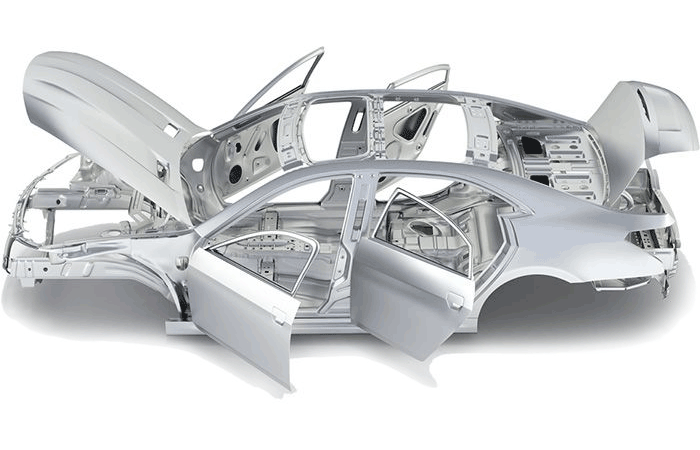By Alison Conroy, Sustainability Chair and Thomas Rudlaff, Managing Director, Alumobility, a global ecosystem of the leading aluminum and enabling downstream technology partners committed to driving value for automakers and consumers.
Circularity – a Change of Paradigm
A revolution in automotive sustainability is underway in the industry. The World Economic Forum and the World Business Council for Sustainable Development (WBCSD) have jointly formed the Circular Cars Initiative, which is charting the course towards a zero-emission future through new technology, materials innovation, efficient vehicle usage and full life-cycle management. [1] The use of aluminum, both primary and recycled, can be a key driver in this multi-year initiative to reduce carbon emissions and improve resource efficiency.
The term circular car refers to a theoretical vehicle that would produce zero materials waste and zero pollution during manufacture, usage, and disposal stages – which differentiates it from today’s zero-emission vehicles. While cars may never be fully circular, the automotive industry can significantly increase its degree of circularity. The four transformative pathways to creating a circular car involve energy decarbonization, material circularity, lifetime optimization and improvement in utilization. [1]
When it comes to material circularity, recycling aluminum is the obvious choice for decarbonizing automotive manufacturing now. Aluminum can be recycled infinitely at a low melting point, so recycling uses only about 5 percent of the energy it takes to produce primary aluminum, reducing carbon emissions by as much as 95 percent. [2]
While decarbonizing the power supply in the smelting process for primary aluminum is underway, it is going to take some time to achieve the desired results. Meanwhile the demand for aluminum, the second-most used material by mass in the auto industry, is expected to grow by 50 percent by 2050.
To help meet that demand and the goal of the Circular Car Initiative to achieve a zero-emission future, closed-loop recycling of vehicle materials such as aluminum, will be key.
The Automotive Industry Homework
To make this work most efficiently in the automotive sector, several things must occur.
Original equipment manufacturers (OEMs) and stamping suppliers need to work together with producers of aluminum alloys to improve scrap collection and sorting to limit the mixing of alloys and to close the loop by sending scrap back to the rolling mills rather than turning it into casting alloys or selling it to scrap dealers. Here’s why:
Recycling within the same alloy family is key to achieving circularity. If different alloys are mixed, the resulting metal is difficult to reuse for its original purpose and often requires the addition of large quantities of primary aluminum.
So, for example, if the scrap from an aluminum uni-alloy car door is sent back to a rolling mill and recycled in a closed-loop process, it can be remanufactured into material for a new car door over and over again. However, if aluminum alloys are mixed in the scrap sorting process with other alloy families, they can no longer be used to manufacture a wrought material (e.g., to produce a door), but will serve as a casting alloy in another value stream. This is a significant missed opportunity for circularity, with a loss in CO2 savings.
Automotive press shops effectively use about 60 percent of the aluminum they receive from sheet suppliers. This means there is a scrap rate of around 40 percent. Today, unfortunately, much of that scrap is recycled in an open-loop system, with the material blended with other alloys and turned into cast aluminum. If the material was recycled with its original alloy content in a closed-loop system, energy consumption and emissions would be reduced and the material would keep its original value.
Introducing as much recycled aluminum sheet as possible to the automobile manufacturing process, particularly in a closed-loop manner, is achievable now and will advance sustainability and carbon emissions initiatives.
Path to Full-Loop Circularity
To further aid in the Circular Car initiative, there is a longer-term opportunity to produce vehicles with end-of-life recycling and reuse at the forefront of the design-build process. This represents a new way of thinking.
Today, there is little end-of-life material sent back to the rolling aluminum industry for recycling and reuse. OEMs can support a more circular business model by designing auto components in a single alloy family for easier sorting and with an eye towards easier dismantling to help ensure end-of-life material is sent back to rolling mills. Mastering this closed-loop aluminum recycling will not only aid in the automotive circularity movement but also help satisfy the growing demand for aluminum, which offers many key advantages over steel and other materials.
Vehicles with significant aluminum content are more efficient, better performing, safer, and more sustainable. Aluminum offers superior durability, corrosion resistance, and energy absorption in a crash. It is fully recyclable, strong, lightweight and can be used to make a wide array of vehicle components.
While achieving circularity within the automobility ecosystem is a complex and time-consuming endeavor, developing the widespread use of aluminum and closed-loop recycling in the automotive sector can be a fundamental building block to carbon neutrality.
For more information about closed loop recycling of automotive aluminum and minimizing carbon emissions, please see our latest whitepaper here.
SOURCE Alumobility


